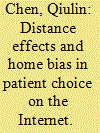| Srl | Item |
| 1 |
ID:
187832


|
|
|
|
|
| Summary/Abstract |
Telemedicine and telehealth hold promise for reducing access barriers caused by travel distance. However, little is known about how the Internet affects patients' online provider choices and thus the spatial distribution of healthcare utilization. This study investigates the effect of distance on flows of online medical consultations using a unique dataset from one of the leading third-party online healthcare platforms in China: Haodf.com. We show that the geographic distance between doctors and patients is negatively associated with online service utilization, though this effect is almost 40% ~ 50% weaker for online medical services than it is for offline medical services. We also find a strong “home bias” in which patients and doctors tend to locate in the same prefecture and in the same province. Further analyses suggest that prior in-person visits before online consultations, the potential need for a follow-up physical visit after an online consultation, and information friction may contribute to the distance effect. These findings have policy implications for improving healthcare access in China and other nations.
|
|
|
|
|
|
|
|
|
|
|
|
|
|
|
|
| 2 |
ID:
153346


|
|
|
|
|
| Summary/Abstract |
It has been well established that better educated individuals enjoy better health and longevity. In theory, the educational gradients in health could be flattening if diminishing returns to improved average education levels and the influence of earlier population health interventions outweigh the gradient-steepening effects of new medical and health technologies. This paper documents how the gradients are evolving in China, a rapidly developing country, about which little is known on this topic. Based on recent mortality data and nationally representative health surveys, we find large and, in some cases, steepening educational gradients. We also find that the gradients vary by cohort, gender and region. Further, we find that the gradients can only partially be accounted for by economic factors. These patterns highlight the double disadvantage of those with low education, and suggest the importance of policy interventions that foster both aspects of human capital for them.
|
|
|
|
|
|
|
|
|
|
|
|
|
|
|
|
| 3 |
ID:
119159


|
|
|
|
|
| Publication |
2013.
|
| Summary/Abstract |
This paper sheds light on the nexus of age compositional shifts and the generation of the first demographic dividend over the past several decades in China, and also discusses how this dividend could be extended We first estimate how long China's first demographic dividend will last and then compare the computed results for China with those for other selected Asian countries in order to place the Chinese case in a wider perspective. Furthermore, in view of the possibility that China's first demographic dividend will turn negative in 2014, we offer insight into how and to what extent China's labor market needs to adjust and how much labor income must increase for the first demographic dividend to remain positive up to year 2050. For this goal to be achieved, the labor income age profile needs to be shifted to a considerable extent. We conduct an exercise in which the 2007 peak labor income age of 32 years is shifted to 40 years. In the case of the elderly, this implies an annual labor income growth of 3.1 percent over the period of 39 years. Throughout this paper, we draw on a variety of computed results derived from the Chinese component of the global "National Transfer Accounts" project.
|
|
|
|
|
|
|
|
|
|
|
|
|
|
|
|